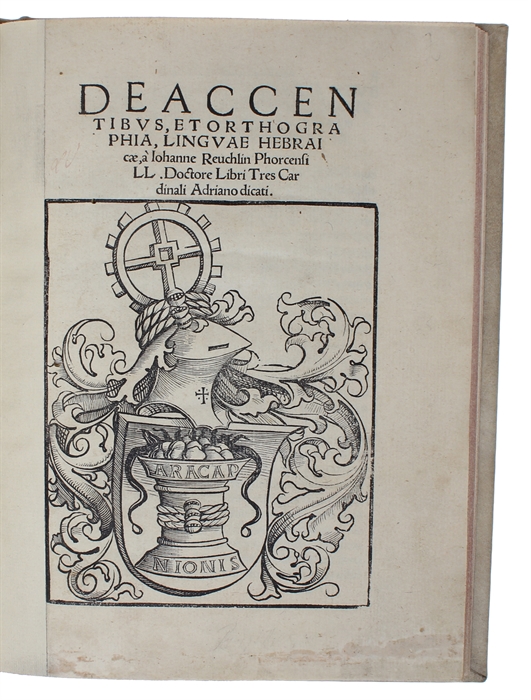THE FIRST EXAMPLE OF NOTATED ASHKENAZI TORAH CANTILLATION
JOHANNES REUCHLIN.
De Accentibus et Orthographia, Linguae Hebraicae [i.e.“Accents and Spelling of the Hebrew Language”].
(Colophon:) Hagenau, Thomas Anshelm, 1518.
Small folio. Bound in a recent full vellum binding with gilt lines and gilt lettering to spine. Title-page re-hinged, affecting neither printing nor woodcut. First leaves with light dampstaining to lower blank margin, far from affecting text. Last portion of leaves with small single worm-holes, mostly marginal, but touching the woodcut at the end. Neat marginal annotations. All in all a very nice copy. Magnificently printed, with three pages with the terms of the Hebrew cantillation printed in red and black, nine pages of musical scores (printed from right to left), extensive use of distinctive Hebrew type, large title-woodcut, and Anshelm's magnificent, large woodcut Printer's device at the colophon (presumably by Anshelm himself, after Dürer). 83, (5) ff.
Scarce first – and only edition – of this groundbreaking work in Jewish musical tradition, being the first work with printed Hebrew music - Reuchlin’s last work of Hebrew grammer, considered a masterpiece of Hebrew typography. Johannes Reuchlin (1455-1522), the important German humanist from the city of Pforzheim, might not be a famous name today, but he played a significant role in his time and was greatly admired by thinkers such as Erasmus, Münster and Melanchthon. He was known as the father of Christian Hebrew studies as well as for his controversial fight against the Dominicans and their attempt to confiscate and burn Jewish books in the early 16th century. Thus, he became a symbol of interreligious tolerance during a period of growing anti-Semitism in Germany. The “De Accentibus” contains a transcription of Hebrew cantillation for four voices. There are 9 pages of musical notes with Hebrew text for Tenor, Discantus, Altus, and Bassus, and the notes are to be read from right to left. Scholars believe the notation was provided by the eminent Christian Hebraist Johann Boschenstein (1472-1540). “In his last work of Hebrew grammar, De Accentibus... (1518), Reuchlin published the first example of notated Ashkenazi Torah cantillation, presenting thirty-four tropes set to four voices. Although this setting is often regarded as a misunderstanding of Jewish monophonic tradition, it gives us an insight to a phenomenon that goes beyond liturgical practice. This musical experiment was meant to serve Hebrew students in their learning of a long lost language among Christians. It combines Jewish and German musical traditions, but also two of Reuchlin's mystical passions: the secrets found in the Hebrew words and letters as proposed in the Kabbalah and the magical effect of harmonies and proportions of Phythagoreanism.” Adams: R:380.
Order-nr.: 59259


![De Accentibus et Orthographia, Linguae Hebraicae [i.e.“Accents and Spelling of the Hebrew Language”].](/images/product/59259b.jpg)
![De Accentibus et Orthographia, Linguae Hebraicae [i.e.“Accents and Spelling of the Hebrew Language”].](/images/product/59259c.jpg)
![De Accentibus et Orthographia, Linguae Hebraicae [i.e.“Accents and Spelling of the Hebrew Language”].](/images/product/59259d.jpg)
![De Accentibus et Orthographia, Linguae Hebraicae [i.e.“Accents and Spelling of the Hebrew Language”].](/images/product/59259e.jpg)
![De Accentibus et Orthographia, Linguae Hebraicae [i.e.“Accents and Spelling of the Hebrew Language”].](/images/product/59259f.jpg)
![De Accentibus et Orthographia, Linguae Hebraicae [i.e.“Accents and Spelling of the Hebrew Language”].](/images/product/59259g.jpg)